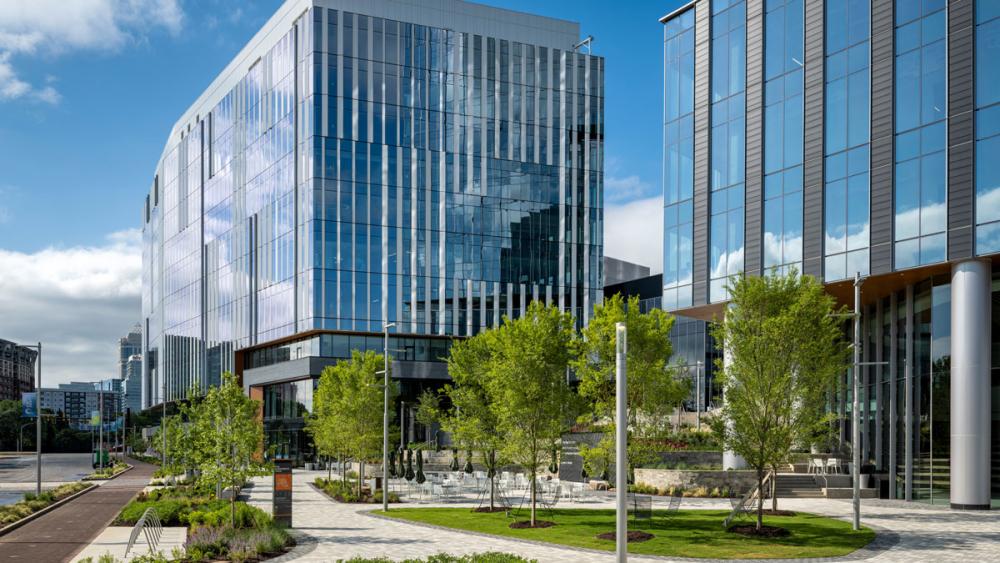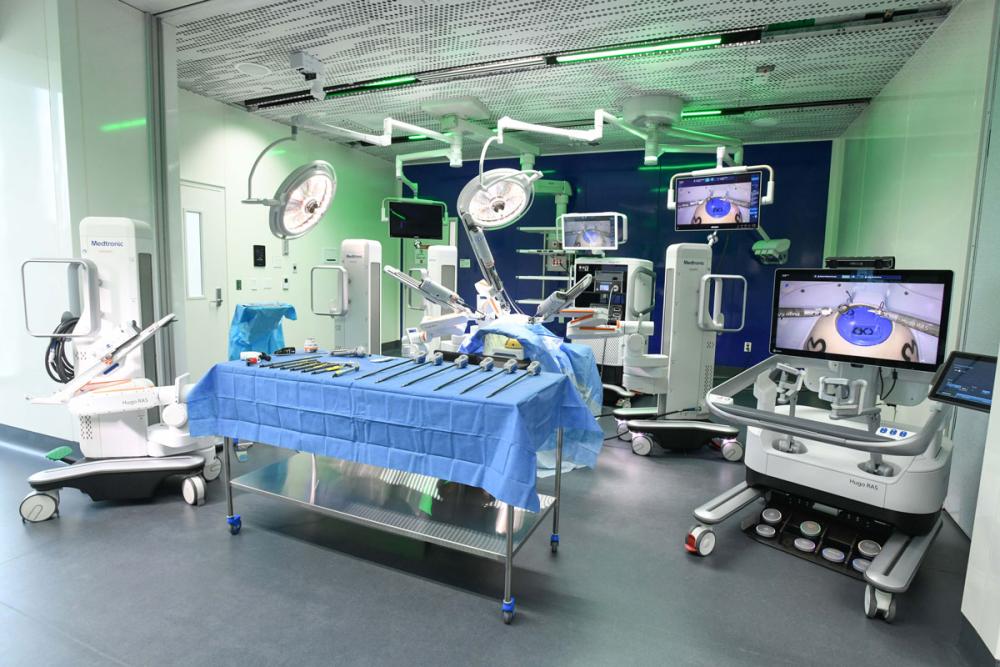
Charlotte, North Carolina, has consistently ranked among the fastest growing cities in the United States for more than two decades, yet during that time, it also has been one of the only major metro areas without a medical school. That just changed. Wake Forest University School of Medicine’s Charlotte campus welcomed its first class in July 2025. The medical school is just one component of The Pearl, a $1.5 billion development that will transform health care and be a catalyst for the city’s continued economic growth and diversification.
Ventas, Inc. (NYSE: VTR), an S&P 500 REIT focused on the secular megatrend of a large and growing aging population, provided the capital for The Pearl and jointly owns the project with its partners Advocate Health, the third-largest nonprofit integrated health system in the U.S., and Wexford Science & Technology, LLC, a private real estate company that partners with universities, research centers, and academic medical centers to create mixed-use “Knowledge Communities.” Alongside its partners, the City of Charlotte and Mecklenburg County, Ventas broke ground on the project in December 2022. The grand opening of The Pearl occurred in June 2025 and marked the completion of the first 700,000 square feet of a multi-phased project potentially encompassing 3.5 million square feet.
“Our investment focus is on the longevity economy,” says Debra A. Cafaro, chairman and CEO of Ventas. “Ventas is a leader at the intersection of medicine, research, and universities, and we partner with first class companies. The Pearl fits squarely in that intersection.”
“We had tremendous local and institutional commitment to The Pearl,” Cafaro says. “Charlotte is a growing city known for its financial services economy and its leaders want to build on that with better health care and a diversified economy.”
The Pearl is the largest public-private partnership in the history of Charlotte, according to Collin Lane, senior vice president of facilities for Advocate Health, and it will bring significant benefits to the city and its residents. The Pearl is anticipated to generate 5,500 jobs on site and more than 11,500 jobs total in the region over the next 15 years, according to city officials.
About the grand opening of The Pearl, Charlotte Mayor Vi Lyles said, “As The Pearl opens its doors, it’s not only a symbol of Charlotte’s ambitions — it’s proof that those ambitions are becoming reality.” She added, “Whether you’re a student, a job seeker, an entrepreneur, a health care professional, or simply proud to call Charlotte home, now is an exciting time to watch our city rise as a life sciences powerhouse.”

The Pearl came together quickly for a project of its size, according to Cafaro, taking three to five years from start to finish.
“For our investors, this has been a jewel of a project since the beginning because all the necessary ingredients were in place, including pre-leasing,” Cafaro says. “The high-end tenants The Pearl has attracted are interested in synergistic interactions—they want to be together in an exceptional space. When you have institutional investment, financial support, experienced partners, and you’re fulfilling a need in the community with a project like this, it dramatically increases the likelihood of success.”
The Pearl’s signature Howard R. Levine Center for Education was 100% preleased, with the entire project, including a state-of-the-art research tower, 905 Pearl Park Way, now more than 80% leased.
Another partner that helped streamline development of The Pearl was Duke Energy, says Ted Russell, president, CEO, and CFO of Wexford. The Pearl is built in a historic neighborhood and Duke Energy worked to bring in the power lines, utilities, and high-speed transmission lines that were needed for the new buildings. They also agreed to bury a lot of the lines and helped in a variety of ways during the entire project, he adds.
Paying Homage to a Community
The Pearl, located in the historic Brooklyn neighborhood of midtown Charlotte, incorporates the community history throughout the development with murals and signs. The neighborhood was predominantly Black residents, but much of its population was displaced during the 1950s through the 1970s due to urban renewal projects and highway construction.
“The community has been very supportive of The Pearl, in part because the development team engaged local residents throughout the planning stages,” Russell says. “In partnership with Advocate Health, we created the ‘Purposeful Walk’ which explains the history of the neighborhood with interactive signs. The Pearl and its open-air plaza called Jacob’s Ladder will also be open to community events.”
Russell says that local residents wanted to feel included in the economic development generated by The Pearl as well as have building access. “Many of the training opportunities and jobs that are generated are available to people without a four-year degree, which makes this project valuable to everyone,” he notes. “The leadership in Charlotte had the strategic vision to diversify the economy so it’s not dependent on the financial services industry. They view growing the academic, health care, and life sciences research fields as essential to growing the Charlotte economy."
Innovative Research and Training Facilities
Wexford has developed nearly two dozen “Knowledge Communities” or “Innovation Districts” that link research universities with entrepreneurs and technology companies to create economic development in their cities and regions.
“We worked with Atrium Health [now part of Advocate Health] on their Wake Forest University School of Medicine in Winston Salem, when Advocate Health’s CEO Gene Woods reached out to us because he wanted to close the gap on health care outcomes,” Russell says.
“At The Pearl and other Knowledge Communities, we bring together primary health care providers, life science researchers, and tech-based companies to leverage the strength of the universities themselves. Those institutions serve as magnetic anchors to attract collaborations with private companies and entrepreneurs,” he adds.
Among the most prestigious tenants at The Pearl is IRCAD North America. “IRCAD is the premium global surgical training center, and this is their first U.S. license,” Russell says. About 8,000 surgeons are expected to come annually for two to five-day programs centered on the latest techniques and devices in cardiovascular, neuro, and orthopedic surgery as well as other types of surgery.

In addition to IRCAD, Siemens is opening a 60,000-square-foot Siemens Healthineers Experience Center USA at The Pearl, which features the latest technologies in imaging, diagnostics, cancer care, and advanced therapies in order to demonstrate them to health care professionals from around the world.
There is also 35,000 square feet of Connect Labs by Wexford scheduled to open in November 2025, comprised of small suites and labs for medical, tech, and life science entrepreneurs, Russell says. “They can interact with physicians in the Advocate Health buildings and with other entrepreneurs. There will be intentional programming with private industry in the field and opportunities for informal interaction,” he notes.
The location of The Pearl was driven in part by Advocate Health’s flagship hospital, Atrium Health Carolinas Medical Center in Charlotte.
“Atrium Health Carolinas Medical Center is one of the largest hospitals in the Southeastern U.S.,” says Lane. It’s the region’s only Level 1 trauma center and provides cancer treatment, transplants, a children’s hospital, and is one of the largest neuroscience centers. “This hospital brings together a high density of super-sub specialists in Charlotte, which is part of why organizations like Siemens and IRCAD are drawn here,” he adds.
Patients and medical professionals come from areas throughout the Southeast for care and training, since the Carolinas Medical Center is the only provider of some specialized treatments between Atlanta and Washington, D.C., Lane points out.
The architecture of The Pearl, meanwhile, contributes to collaboration, according to Lane. “The buildings are deliberately not siloed because we think it’s a value proposition to have undergraduates, faculty members, and researchers work adjacent to each other and alongside a training platform,” he says.
Investing in a Pipeline of Trained Professionals
The Wake Forest University School of Medicine location at The Pearl is just one part of a systematic plan to generate more highly qualified health care providers in Charlotte.
“When Wake Forest announced their intention to build a second medical school in Charlotte, there was an immediate reaction that other people in the health care industry wanted to locate nearby,” Lane says. “There are hundreds of companies in the area who could find synergies with medical researchers and other professionals.”
Advocate Health has academic relationships with numerous colleges and universities, not just Wake Forest, with the premise that multiple avenues can create a talent pipeline for health care providers. The Carolinas College of Health Sciences, co-located with the Wake Forest University School for Professional Services, is owned by Advocate Health.
“Advocate Health has also partnered with Charlotte-Mecklenburg Schools to create a STEM program for fifth to eighth graders to bring students on field trips and engage them in other ways so they can envision themselves in various health care roles,” Lane says. “There’s an early college program from ninth grade on for students to start taking classes to prepare for a health care career.”
Creating that pipeline of talent will also attract people in other related industries to Charlotte, Lane says. In turn, the programs can be tailored to meet their needs for future employees, he says.

Catalyst for Economic Growth
The scale of this project required a significant number of construction jobs, Cafaro says, plus more ongoing jobs are anticipated to be created over time. “About 40% of the jobs will be suited for people without college degrees,” Cafaro says. “The Pearl will serve as an economic multiplier and is expected to attract further development, such as a hotel, and perhaps additional research and medical facilities.”
“A key lesson from The Pearl is the importance of finding the right partners,” Cafaro says. “Each individual partner connected with the others and contributed their unique experience. Collaboration made this project special and the continued commitment from partners and tenants will benefit the entire Charlotte community, and health care professionals from around the world. We’re so proud to be a part of creating an environment where health care providers and researchers can work together to improve human health locally and globally."
